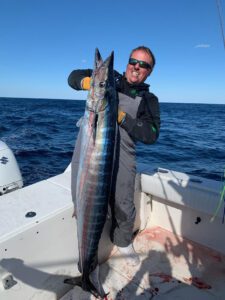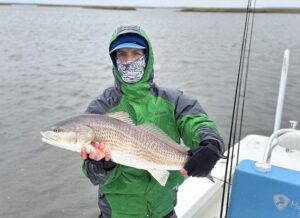Carolina Beach – December 2023
Lewis, of Island Tackle and Hardware, reports that surf anglers have been catching pufferfish, whiting, and rays. The Cape Fear River has been producing some speckled trout, and down at the mouth of the river, a bunch of whiting are being caught. Nearshore anglers were finding Atlantic bonito that made an unexpected showing. Anywhere from the beach out to three miles has held schools.
Bluefish and black sea bass are being found by those fishing over the nearshore ARs. Offshore runs are producing wahoo and blackfin tuna, and bottom fishing efforts are enjoying steady action from the various grouper/snapper species. Going into winter, the surf bite will slow down a bunch, so anglers looking for some action will do best in the Cape Fear targeting striped bass upriver and red drum in lower river bays.
Christian, of Seahawk Inshore Fishing Charters, reports that anglers are catching plenty of smaller red drum, with a few slot-sized ones in the mix. Soft plastics, mud minnows, or dead shrimp have all been doing the trick. The best action has been found on the warmer days during the lower tide cycles that help congregate the fish.
Black drum can be found mixed back in the creeks and up on flats with the reds. When in the creeks, a dead shrimp fished along the bottom up against marsh banks or shell points will provide the best opportunities. Most of these wintertime black drum will be in the 14-16” range.
Speckled trout are still pretty scattered as they continue to push into rivers and creeks in the lower Cape Fear River. Live shrimp has been the hot ticket for fishing these creek mouths, with the falling tide again seeing the better action.

Jeremiah Goldsmith, of Carolina Beach, found this 60.3 lb. wahoo 60 miles out of the Cape Fear River mouth using a Sea Witch and ballyhoo. He was fishing aboard the Fishin Coalition.
Luke, of Spot On Charters, reports that speckled trout fishing has been pretty good, with anglers catching fish to 6 lbs. Due to the colder weather, these trout have started feeding more through the day versus the early mornings and evenings. On nice weather days, look for areas of current with choke points and 5-6’ depths. When it’s windy, tuck into a deeper pocket with some moving water. Red drum are scattered. The reds haven’t quite pushed into their larger winter schools, so finding them requires a bunch of moving around to different spots.
Tommy, of Mungo Fishing Charters, reports that red drum are schooling up and staging on the shallow flats and in the marsh bays. On calm days, anglers can sight cast to these schools using an assortment of soft plastics.
Red drum can be found hanging around some of the deeper water docks and holes in mainland creeks. Carolina-rigged dead shrimp or live mud minnows can entice a strike when fishing these areas. Anglers are having success speckled trout fishing with a wide variety of hard baits and scented soft plastics. Areas of structure (such as rocks and oyster points or a creek mouth) have been the top producers.
Black drum can be caught in the area all winter long. The deeper rocks and deep holes off the sides of oyster bars are typically the best spots to target. Striped bass bite each winter up the Cape Fear River around the downtown area, and this catch-and-release fishery is another option for anglers looking to fish artificials.
Mason, of Grand Slam Fishing Charters, reports that anglers can find red drum in the backs of creeks where there are deeper holes (6-8’) with mud bottoms. Nearby shell bottoms are another bonus. Shrimp rigged on a 1/4 oz. jig heads or lightweight Carolina rigs will be great setups. Anglers can also cruise the flats looking for schools of red drum. Be ready to cover a lot of water looking for wakes and fish movement, and casting a Gulp shrimp is a strong tactic for fishing these schools.
The speckled trout bite should be good as long as water temperature stay over 50 degrees. MirrOlure MR-17s are a favorite lure for a reason, as they have a lot of success. Fish them very slow in current seams and eddies to produce bites from the winter trout, and if you have it, live shrimp under a cork is a great bait as well.
Striped bass will start showing better in the Cape Fear River. To entice strikes, target moving water in the ditches and creek mouths and work swimbaits and bigger jerk shads. Anglers can also find striped bass on deeper ledges with structure (15-20’ range). Vertical jig these areas with soft plastics on 1/4-3/4 oz. jig heads.

Aaron Smith, of Alexandria, VA, caught this 28.5″ (9 lb. 5 oz.) red drum in the Cape Fear River using a Gulp shrimp on a jig head.
Rod, of OnMyWay Fishing Charters, reports that king mackerel fishing has been fantastic, and anglers will continue to see strong action through December. Anglers are finding a good class of fish (to 30 lbs.), with action best around the 22-mile area. Focus on the water edges with 68-70 degree water temperatures, and productive bait options have been cigar minnows on Blue Water Candy dead bait rigs or Blue Water Candy sea witches with a strip of albacore belly.
Anglers will also be finding false albacore around the kings. December through March are prime times for targeting ledges in the 18-25 mile range for big black sea bass. Some of these same bottom areas will also hold big grunts and gag grouper.
The 35-40 mile range is holding reds and scamps, as well as vermilion snapper and porgies. Anglers running out to the break are finding some wahoo, with blackfin tuna and sailfish mixed in. Around Christmas, the area could see the arrival of bluefin tuna. Anglers rigged for this fishery will be slow trolling big live baits or select and horse ballyhoo.
Jeremiah, of Kure Beach Pier, reports that anglers that got out for the last few days of the pier fishing season caught good numbers of sea mullet and some slot-sized red drum (to 23”).





